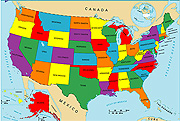
TUESDAY, March 13 (HealthDay News) — The foods Americans eat have a lot to do with factors like race, age and where they live, and can be categorized into five distinct dietary patterns, according to a new study.
Researchers analyzed food questionnaires from a large group of black and white adults aged 45 and older in the continental United States, with a focus on southeastern states.
The strongest association they found was that black people were more likely than whites to have “southern” diets, which are rich in fried foods, processed meats and sweetened drinks.
“Nobody has defined dietary patterns in a population like this,” said Suzanne Judd, assistant professor at the University of Alabama at Birmingham and study co-author.
The findings are slated for Tuesday presentation at the American Heart Association meeting in San Diego.
The southern diet probably emerged as a clear trend because the study included so many participants from the Southeast, Judd added.
In addition to the southern diet, the authors identified four other eating patterns.
The “traditional” pattern was characterized by a mixed diet of mostly takeout and prepared foods.
A “healthy” diet was mostly made up of fruits, veggies and grains.
“Sweets” consisted largely of sweet snacks and desserts.
An “alcohol” pattern, which included salads, proteins (and alcohol), was associated with younger ages and higher socioeconomic status.
The researchers limited their study to black and white adults because the largest difference in stroke risk exists between these two racial groups. Previous research has found that black people are three times more likely to have a stroke than their white counterparts at 45 years of age, although the gap in risk shrinks in older adults.
People from the Southeast region, known as the “stroke belt,” are also more likely to suffer a stroke.
The current study involved nearly 22,000 adults, half of whom lived in the Southeast, representing a range of income and education levels.
Participants filled out a food frequency questionnaire about their diet over the past year. From these responses, the researchers grouped similar foods into categories, then looked at how food groups were consumed together to define dietary patterns. Participants each received a score reflecting how closely their diet resembled each pattern.
The researchers identified a number of trends, notably that younger age groups (45-54 years) were more likely than older adults to have a traditional diet, which features convenient, ready-to-eat foods.
And while black participants were associated with a southern diet, white people were more likely to have a traditional or sweet diet. These diet differences could not be explained by income and education differences alone, Judd said, adding that culture and upbringing probably play a part in eating habits.
Previous research suggests that one of the major culprits for increased stroke risk among black people is high blood pressure. The southern diet, and in particular sodium intake, probably has an effect on stroke risk by driving up blood pressure, although it may have other important effects, such as on obesity, Judd said.
“Not maintaining a healthy weight leads to so many problems in terms of how well blood vessels function,” she explained.
Although studies have explored the intake of individual nutrients, such as sodium and calcium as well as fats and fiber, among black and white people, there is a less clear understanding of how overall diet differs between these groups.
Commenting on the study, Connie Diekman, director of university nutrition at Washington University in St. Louis, said, “We have to start looking at dietary patterns because it is about the whole of what we do; it is not single nutrients or single foods that are the cause or the blame for disease.”
When it comes to helping people change their eating habits, dietary patterns are also more useful than labeling foods as “good” and “bad,” Diekman added.
The next step is to look at the relationship between these dietary patterns and health, in particular stroke risk. “I’ll be surprised if we don’t see an association,” Judd said.
If further research shows an association, it would provide some foods to target, similar to how the U.S. Centers for Disease Control and Prevention is working to reduce sodium in the food supply, Judd said.
“Even from just what is here [in this study], it certainly will add to the body of evidence that’s encouraging the change in sodium, portions, and the increased need for education around nutrition and physical activity,” Diekman said.
Because this study was presented at a medical meeting, the data and conclusions should be viewed as preliminary until published in a peer-reviewed journal.
More information
There’s more on healthy eating at the U.S. Department of Agriculture.

